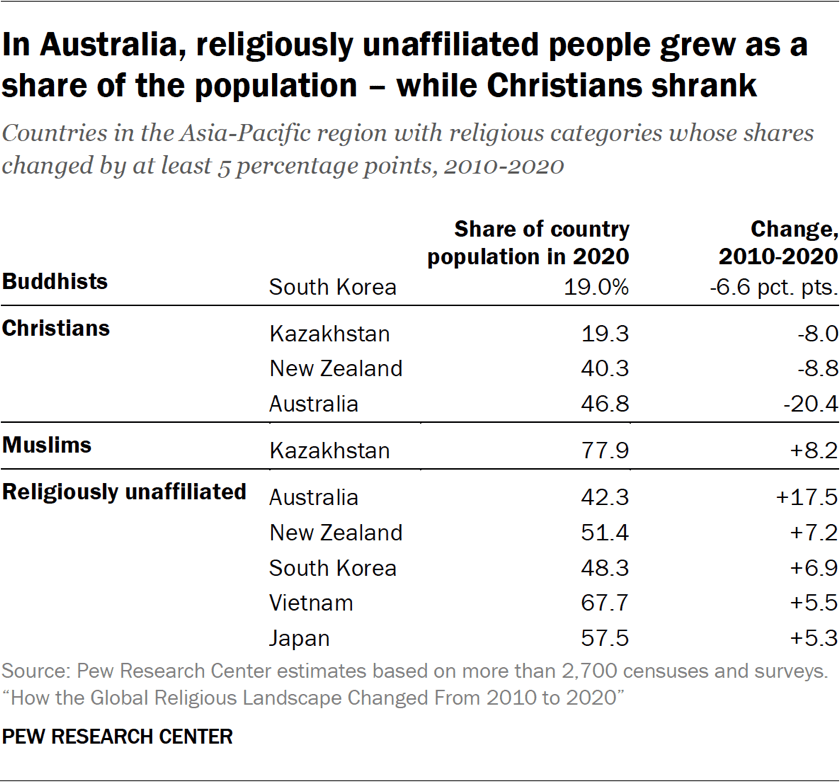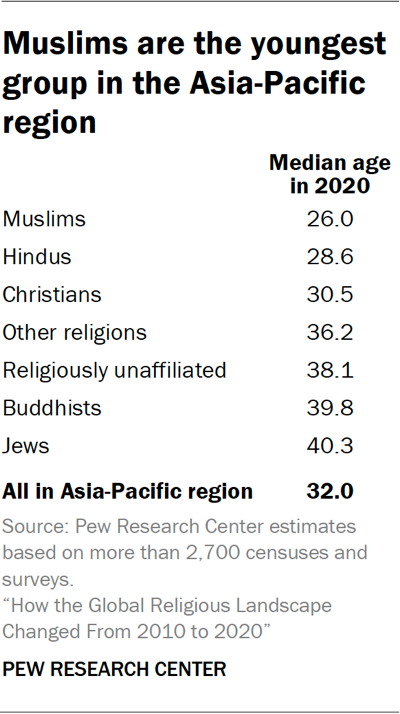As of 2020, the Asia-Pacific region is home to 4.5 billion people, 10% more than in 2010. This large and religiously diverse region – where no single religious group constitutes a majority of the population – includes more than 1 billion each of Hindus, Muslims and religiously unaffiliated people. The region also has hundreds of millions of Buddhists, Christians and people in the “other religions” umbrella category.
The vast majority of the world’s Hindus (99%) and Buddhists (98%) live in the Asia-Pacific region. Most of the world’s Muslims (59%), adherents of other religions (65%) and religiously unaffiliated people (78%) also reside in this region.
The heavy concentration of all these groups in Asia and the Pacific is due to the region’s religious diversity and history, as well as its massive population (a majority of the world’s inhabitants). Hinduism, Buddhism and many religions that fall into the “other religions” category – including Daoism (also spelled Taoism), Jainism, Shintoism and Sikhism – were founded in the region.
Nearly 95% of the world’s Hindus live in one country: India, where Hindus make up 79% of the nation’s 1.4 billion people. Adherents in the “other religions” category make up less than 3% of India’s population as of 2020, but even that small share is a lot of people. India contains 21% of all the people in the world who belong to the “other religions” category. (For more about India’s religious landscape, refer to our 2021 report on how the religious composition of India changed from the 1990s through 2010.)
A majority of the world’s religiously unaffiliated people live in China (67%), which was the world’s most populous country in 2020, though it has since been surpassed in size by India. Fully 90% of China’s population is religiously unaffiliated. (Refer to our 2023 report “Measuring Religion in China” for additional context, including a summary of recent Chinese government policy toward religion.)

Religious change
Most groups in the Asia-Pacific region grew in absolute number between 2010 and 2020. Growth in population count was greatest for Muslims (up 16%), Hindus (up 12%) and the religiously unaffiliated (up 10%). As of 2020, the religiously unaffiliated were the largest group in the region, with nearly 1.5 billion people. Muslims and Hindus each numbered about 1.2 billion.
Buddhists are the only group that shrank in number, to 316 million in 2020, down 6% over the preceding decade. This decline was partly due to religious disaffiliation, particularly in some East Asian countries with large Buddhist populations. In addition, Buddhism is declining for demographic reasons, including relatively low fertility rates and an older age distribution.
There were modest changes in the percentage (or share) that each religion made up of the region’s overall population. The share of the region’s population that is Muslim grew to 26% (up about 1 percentage point), while the share of the population that is Buddhist decreased by about 1 point, to about 7%.
Overall, the share of the region’s population that is religiously unaffiliated was stable. However, this stability masks more complex patterns at the individual country-level.
Substantial change within countries
Several countries in the Asia-Pacific region saw a substantial shift (of at least 5 percentage points) in one or more religious group’s share of the total population between 2010 and 2020. The religiously unaffiliated grew considerably in five countries (Australia, New Zealand, South Korea, Vietnam and Japan), while Christians shrank in three (Kazakhstan, New Zealand and Australia). Buddhists declined in South Korea and Muslims grew in Kazakhstan.
Australia showed the most change. Between 2010 and 2020, Australia’s Christian population fell from 67% to 47% of the country’s total population (down 20 points), while the religiously unaffiliated grew to represent 42% of the country’s inhabitants (up 17 points). Australia is one of four countries around the world that had a Christian majority in 2010 but not in 2020.

Median age of religious groups
The age structure of populations varies greatly by religion across Asia and the Pacific. Three groups – Muslims (26 years), Hindus (29) and Christians (31) – have median ages that are lower than the region’s overall median age (32). The figure is much higher among religiously unaffiliated people (38), Buddhists (40) and Jews (40).

The age patterns by religion in Asia and the Pacific mirror those in other regions. Globally, Muslims have the lowest median age of all major religious groups, followed by Hindus; most members of these two religions around the world are under 30.
Christians, followers of other religions, and religiously unaffiliated people are the next-youngest groups, both in the Asia-Pacific region and worldwide. Both in the Asia-Pacific region and globally, Buddhists and Jews have the highest median ages.




